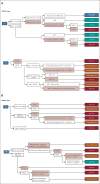Revised Neuroblastoma Risk Classification System: A Report From the Children's Oncology Group
- PMID: 34319759
- PMCID: PMC8500606
- DOI: 10.1200/JCO.21.00278
Revised Neuroblastoma Risk Classification System: A Report From the Children's Oncology Group
Abstract
Purpose: Treatment planning for children with neuroblastoma requires accurate assessment of prognosis. The most recent Children's Oncology Group (COG) risk classification system used tumor stage as defined by the International Neuroblastoma Staging System. Here, we validate a revised classifier using the International Neuroblastoma Risk Group Staging System (INRGSS) and incorporate segmental chromosome aberrations (SCA) as an additional genomic biomarker.
Methods: Newly diagnosed patients enrolled on the COG neuroblastoma biology study ANBL00B1 between 2007 and 2017 with known age, International Neuroblastoma Staging System, and INRGSS stage were identified (N = 4,832). Tumor MYCN status, ploidy, SCA status (1p and 11q), and International Neuroblastoma Pathology Classification histology were determined centrally. Survival analyses were performed for combinations of prognostic factors used in COG risk classification according to the prior version 1, and to validate a revised algorithm (version 2).
Results: Most patients with locoregional tumors had excellent outcomes except for those with image-defined risk factors (INRGSS L2) with MYCN amplification (5-year event-free survival and overall survival: 76.3% ± 5.8% and 79.9% ± 5.5%, respectively) or patients age ≥ 18 months with L2 MYCN nonamplified tumors with unfavorable International Neuroblastoma Pathology Classification histology (72.7% ± 5.4% and 82.4% ± 4.6%), which includes the majority of L2 patients with SCA. For patients with stage M (metastatic) and MS (metastatic, special) disease, genomic biomarkers affected risk group assignment for those < 12 months (MYCN) or 12-18 months (MYCN, histology, ploidy, and SCA) of age. In a retrospective analysis of patient outcome, the 5-year event-free survival and overall survival using COG version 1 were low-risk: 89.4% ± 1.1% and 97.9% ± 0.5%; intermediate-risk: 86.1% ± 1.3% and 94.9% ± 0.8%; high-risk: 50.8% ± 1.4% and 61.9% ± 1.3%; and using COG version 2 were low-risk: 90.7% ± 1.1% and 97.9% ± 0.5%; intermediate-risk: 85.1% ± 1.4% and 95.8% ± 0.8%; high-risk: 51.2% ± 1.4% and 62.5% ± 1.3%, respectively.
Conclusion: A revised 2021 COG neuroblastoma risk classifier (version 2) that uses the INRGSS and incorporates SCAs has been adopted to prospectively define COG clinical trial eligibility and treatment assignment.
Conflict of interest statement
Figures


References
-
- Irwin MS, Park JR: Neuroblastoma: Pediatric paradigm for precision medicine. Pediatr Clin North Am 62:225-256, 2015 - PubMed
-
- Brodeur GM, Pritchard J, Berthold F, et al. : Revisions of the international criteria for neuroblastoma diagnosis, staging, and response to treatment. J Clin Oncol 11:1466-1477, 1993 - PubMed
Publication types
MeSH terms
Grants and funding
LinkOut - more resources
Full Text Sources
Medical

